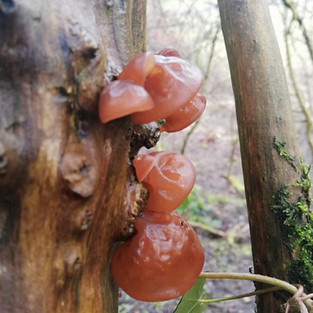This week's Friday Fungi is the jelly or wood ear fungus. It can be found most commonly on dead elder trees and grows across Britain, Ireland, Europe, North America, Asia and Australia.
This wobbly, gelatinous fungus has a velvety outer layer which feels soft to the touch. It's obvious how it come upon its name as is likeness to a human ear is a little spooky. Jelly ear fungus is safe to touch and is eaten in China where it's added to hot and sour soups. I've never tried eating jelly ear and suggest it's best left on the tree where it has an important job to do...
Here's a video of some Jelly Ear growing near the White Cart.
Jelly ear is a bracket fungus which means it grows out of a tree trunk or branch like a bracket. It belongs to a group of fungus called 'decomposers' or 'saprotrophs'. These fungi can't photosynthesize like trees and plants do to get food which means they need to find food elsewhere. They feed from the organisms they live on, the dead Elder tree. Using potent enzymes the jelly ear breaks down the wood (lignin) and recycles it, depositing nutrients into the soil. Decomposers eventually convert all organic matter (dead wood) into carbon dioxide and nutrients. This releases raw nutrients (such as nitrogen, phosphorus, and magnesium) in a form usable to plants and algae. This process resupplies nutrients to the ecosystem. Fungi also use the nutrients for their own growth and repair. How amazing is the jelly ear? :)
Happy fungus finding
Take care,
W.I.L.D.
There's lots of information out there if you want to find out more.













Comments